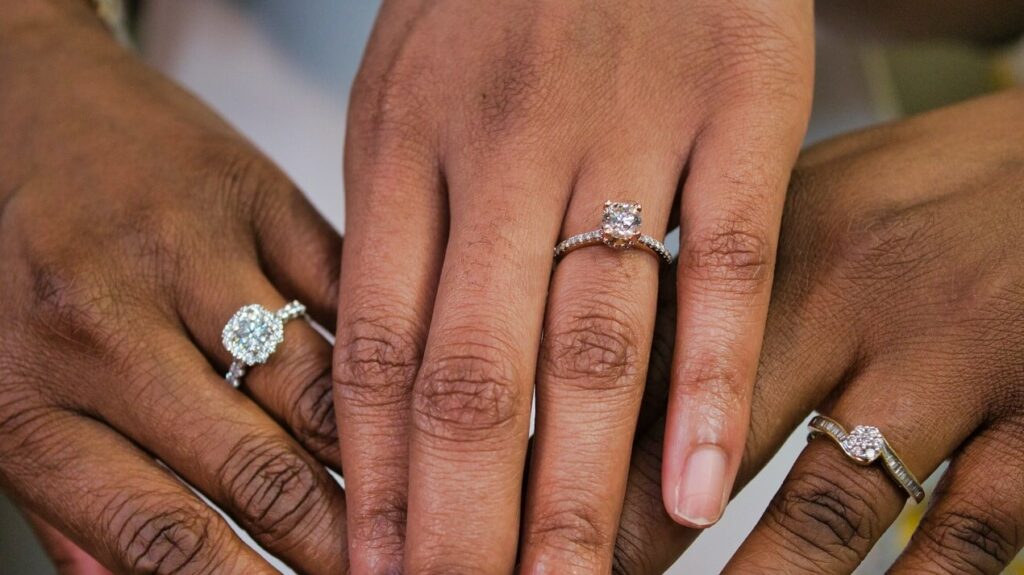FREE INTERNATIONAL DELIVERY
ETHICALLY SOURCED DIAMONDS
60 DAY RETURN POLICY
21st December 2023

One of the first things to consider when buying a diamond engagement ring is the type of band that will hold the diamond. Some types of settings can make a diamond look more prominent, while others can make it appear brighter or sparklier.
Certain settings will also work better with different diamond shapes and cuts. The ring setting should also reflect your partner’s style. This guide will help you choose the right setting, whether your partner prefers classic elegance or something more elaborate.
There are a lot of different engagement ring settings available. We will focus on some of the most popular ones.

The prong diamond ring setting features four or six evenly spaced prongs (also called claws) extending from the top of the ring to hold the diamond safely in place. The prongs can be rounded or flat. This type of setting can hold any diamond shape, including round, princess, oval, cushion and heart. It is the most popular type of setting as it allows the light to enter the diamond from all sides for maximum sparkle and fire.

Like the prong setting, a basket set ring has claws extending from the top of the band to hold the stone in place. But it also features horizontal bands which connect the prongs, creating a base for the central diamond to be set in. It holds the prongs together so they are less likely to bend. However, the horizontal bars block some of the light from entering the diamond.

The bezel setting holds the centre diamond securely inside a thin gold rim. This type of setting protects the stone better than other settings, but it partially hides the diamond and blocks the light from entering it, so the diamond might appear smaller and lose some of its sparkle.

The tension ring setting uses compression to hold the diamond in place. The most common type of tension band design is the swirl setting, which gives the ring a twist-like appearance as the metal wraps around parts of the diamond in a protective embrace. This type of setting looks elegant but doesn’t allow light to enter the diamond from all sides.

From the top, a trellis-set ring looks like a regular prong-set ring. However, the claws of the trellis band, usually four or six, are twisted together, creating a woven basket appearance. When looking from the side, the overlapping claws of the trellis setting form a stylised X shape. This type of setting works best with the round and princess cuts and can hold one, three or five stones.

A solitaire diamond engagement ring features a single diamond in a plain gold or platinum band, so the main focus is on the diamond for a timeless and elegant look. When used with the prong setting, the light can enter the diamond from all sides, giving it brilliant sparkle and fire. This setting can be used for diamonds of all sizes, cuts and shapes.

Rings with pave settings feature rows of tiny diamonds on the band’s shoulders next to the central diamond to accentuate the main stone and add even more sparkle. This setting is suitable for any diamond shape. Most pave-set engagement rings have between 5 and 10 pave diamonds, each weighing between 0.01 and 0.03 carats on each side of the central diamond.

Cathedral engagement ring settings are fundamentally prong or basket set rings with the addition of two arches that rise above the band to give the ring extra height. The arches of the cathedral ring can be plain or embellished with pave diamonds.

We designed our unique regency ring setting after many of our customers asked us to create a wider band adorned with pave diamonds. Strong, classy and elegant, this setting is the perfect choice for a diamond engagement ring and works best with a round diamond.

Halo diamond engagement rings feature small pave diamonds set in a circle around the central stone. Halos are usually the same shape as the main stone, but they can occasionally be different. For example, a round diamond can have a cushion-cut halo. This setting works best with the round, cushion, oval and pear cuts.

This setting, also called a trilogy ring, has three diamonds set next to each other side-by-side. Each of the three diamonds symbolises a different phase in life – the past, the present, and the future. Trilogy settings work best with round-cut and emerald-cut diamonds. The three diamonds can be the same size, or the central stone can be larger.